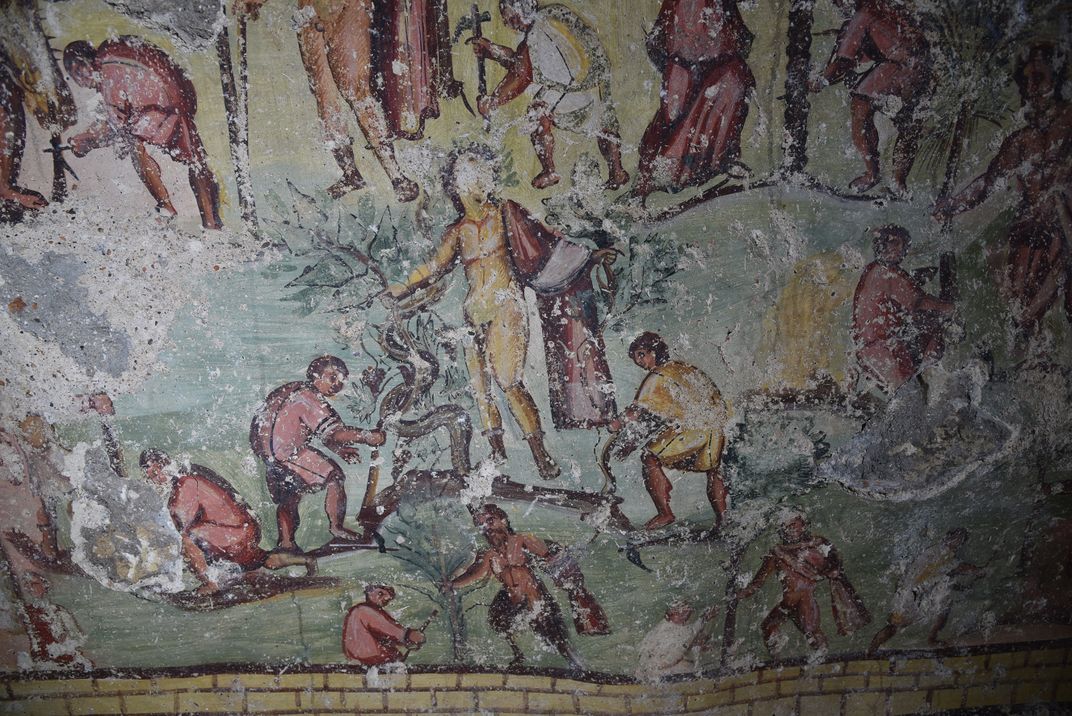Ancient Comics Line This Roman-Era Tomb in Jordan
Some of the nearly 260 figures depicted in the paintings are given speech captions reminiscent of modern comics
/https://tf-cmsv2-smithsonianmag-media.s3.amazonaws.com/filer/e8/01/e8011fde-ee25-4eac-8486-8c1a96c4d4ef/bayt-ras_figure_02.jpg)
When people talk about old comics, strips like Little Orphan Annie or Nancy probably come to mind. But archaeologists in Jordan recently uncovered a truly old incarnation of the form. Painted on the walls inside a 2,000-year-old Roman-era tomb, Ariel David at Haaretz reports that there are nearly 260 figures featured in narrative scenes, with many speaking via comic-style speech bubbles.
The tomb was discovered during road construction in 2016 near the town of Bayt Ras, north of Irbid, Jordan. Since that time, Jordanian and foreign experts have studied the tomb, believed to be part of a necropolis. “The tomb is located on the site of the ancient city of Capitolias, which was founded in the late 1st century C.E., and was part of the Decapolis, a region that brought together Hellenized cities (provided with Greek-style institutions but belonging to the Roman Empire) in the southeastern area of the Near East, between Damascus and Amman,” Julien Aliquot, a researcher from Histoire et sources des mondes antiques (HiSoMA), which is studying the site, says in a press release.
The figures on the wall are in good condition though there is some sign that the tomb was looted sometime before its official discovery. The colorful images capture a vibrant, thriving city on the outskirts of the Roman Empire— there are gods of Olympus feasting together and being served by humans, peasants tending their fields and grapevines, lumberjacks cutting down trees, as well as detailed panels of architects and workers building the city. On the ceiling, the paintings depict the Nile and the marine world as well as frolicking cupids.
Perhaps the most striking feature for modern viewers are the little captions that appear next to some of the figures. “These 60 or so texts painted in black, some of which we have already deciphered, have the distinctive feature of being written in the local language of Aramaic, while using Greek letters,” researcher Jean-Baptiste Yon says in the release. “This combination of the two primary idioms of the ancient Near East is extremely rare, and will help to better identify the structure and evolution of Aramaic. The inscriptions are actually similar to speech bubbles in comic books, because they describe the activities of the characters, who offer explanations of what they are doing (‘I am cutting (stone),’ ‘Alas for me! I am dead!’), which is also extraordinary.”

As a whole, the comic strip tells a story of sorts. The researchers believe that the panels document the founding of the city, with the first banquet scene showing the gods deciding on where to locate Capitolias. Succeeding panels capture people clearing land for the city, building its walls and celebrating their work with a sacrifice to the patron deity of the city, Jupiter Capitolinus.
“According to our interpretation, there is a very good chance that the figure buried in the tomb is the person who had himself represented while officiating in the sacrifice scene from the central painting, and who consequently was the founder of the city,” historian Pierre-Louis Gatier says in the release. “His name has not yet been identified, although it could be engraved on the lintel of the door, which has not yet been cleared.”
While the comics are interesting, David of Haaretz points out that we can’t call them the first comics. Some older images from ancient Egypt contain similar captions and, depending on your definition of a comic, Neolithic cave paintings of hunting scenes might be earliest progenitor of the X-Men.
In any case, the images are interesting and may help researchers learn more about the culture and people of Capitolias and the Decapolis’s league of 10 cities—later 14—on the eastern edge of the Roman Empire stretching between modern-day Jordan into parts of Israel and Syria.